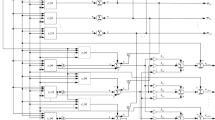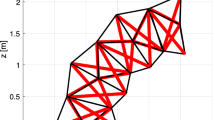Abstract
In this paper, the form-finding of symmetric tensegrity structure is discussed and investigated by means of force density method and neural network algorithm. An optimization model based on the rank deficiency maximization is established to solve feasible force density, and the nodal coordinates are determined by eigenvalue decomposition of force density matrix. Then, the Lagrangian multiplier method can transform constrained optimization problem into unconstrained optimization problem. To avoid high-dimensional Hessian matrix calculation, noise-tolerant neural algorithm (NTNA) is exploited to calculate the unconstrained optimization problem. Numerical results indicate that the proposed noise-tolerant neural-based quasi-Newton Broyden–Fletcher–Goldfarb–Shanno (NTN-QNBFGS) form-finding method enhances convergence speed. Furthermore, the consistency between the form-finding results and analytical solutions infers that the developed method can be effectively applied to the form-finding of tensegrity robot.








Similar content being viewed by others
Explore related subjects
Discover the latest articles, news and stories from top researchers in related subjects.Data availability
The datasets generated and analyzed during the current study are available from the corresponding author on reasonable request.
References
Zhang LY, Jiang JH, Wei K, Yin X, Xu GK, Zhang JY (2021) Self-equilibrium and super-stability of rhombic truncated regular tetrahedral and cubic tensegrities using symmetry-adapted force-density matrix method. Int J Solids Struct 233(15):111215
Koohestani K (2020) Innovative numerical form-finding of tensegrity structures. Int J Solids Struct 206(1):304–313
Heng TT, Zhao LM, Liu KP, Yi J, Duan XQ, Sun ZB (2021) An improved form-finding method for calculating force density with group theory. In: 11th international conference on intelligent control and information processing (ICICIP), pp 126–131
Wang Y, Xu X, Luo Y (2020) Topology-finding of tensegrity structures considering global stability condition. J Struct Eng 164(12):04020260
Tran HC, Lee J (2010) Advanced form-finding of tensegrity structures. Comput Struct 88(3–4):237–246
Koohestani K (2017) On the analytical form-finding of tensegrities. Compos Struct 166(15):114–119
Elizabeta S, Krešimir F, Maja B (2018) Increasing efficiency of iterative use of the force density method. J Croat Assoc Civ Eng 69(12):1075–1084
Mohammad M, Keong CK, Yeol KJ, Won KJ (2018) Linear form finding approach for regular and irregular single layer prism tensegrity. Int J Steel Struct 18(5):1654–1665
Zhang LY, Zhu SX, Lia SX, Xu JK (2018) Analytical form-finding of tensegrities using determinant of force-density matrix. Compos Struct 189(1):87–98
Xu X, Wang YF, Luo YZ (2018) Finding member connectivities and nodal positions of tensegrity structures based on force density method and mixed integer nonlinear programming. Eng Struct 166(1):240–250
Liew A (2020) Constrained force density method optimisation for compression-only shell structures. Structures 28:1845–1856
Zhang P, Zhou JK, Chen JS (2021) Form-finding of complex tensegrity structures using constrained optimization method. Compos Struct 268(15):113971
Chen Y, Sun QZ, Feng J (2018) Improved form-finding of tensegrity structures using blocks of symmetry-adapted force density matrix. J Struct Eng 144(10):04018174
Yuan X, Ma S, Jiang S (2017) Form-finding of tensegrity structures based on the Levenberg–Marquardt method. Compos Struct 192:171–180
Vinicius A, Hojjat A (2019) Form-finding and analysis of hyperelastic tensegrity structures using unconstrained nonlinear programming. Eng Struct 191(15):439–446
Branam NJ, Arcaro V, Adelic H (2019) A unified approach for analysis of cable and tensegrity structures using memoryless quasi-newton minimization of total strain energy. Eng Struct 179(15):332–340
Wang YF, Xu X, Luo Y (2021) A unifying framework for form-finding and topology-finding of tensegrity structures. Eng Struct 247(15):106486
Wang YF, Xu X, Luo Y (2021) Form-finding of tensegrity structures via rank minimization of force density matrix. Eng Struct 227(15):111419
Jin L, Li S, Liao BL, Zhang ZJ (2017) Zeroing neural networks: a survey. Neurocomputing 267(6):597–604
Jin L, Zhang YN (2015) Discrete-time Zhang neural network for online time-varying nonlinear optimization with application to manipulator motion generation. IEEE Trans Neural Netw Learn Syst 26(7):1525–1531
Li XX, Yu JG, Li S, Ni LN (2018) A nonlinear and noise-tolerant ZNN model solving for time-varying linear matrix equation. Neurocomputing 317(23):70–78
Li WB, Liao BL, Xiao L, Lu RB (2019) A recurrent neural network with predefined-time convergence and improved noise tolerance for dynamic matrix square root finding. Neurocomputing 337(14):262–273
Stanimirović PS, Katsikis VN, Li S (2019) Integration enhanced and noise tolerant ZNN for computing various expressions involving outer inverses. Neurocomputing 239(15):129–143
Xiao L, Zhang YS, Dai JH, Chen K, Yang S, Lie WB, Liao BL, Ding L, Li JC (2019) A new noise-tolerant and predefined-time ZNN model for time-dependent matrix inversion. Neural Netw 117:124–134
Wei L, Jin L, Yang CJ, Chen K, Li WB (2021) New noise-tolerant neural algorithms for future dynamic nonlinear optimization with estimation on hessian matrix inversion. IEEE Trans Syst Man Cybern Syst 51(4):2611–2623
Liao S, Liu JY, Xiao XC, Fu DY, Wang GC, Jin L (2020) Modified gradient neural networks for solving the time-varying Sylvester equation with adaptive coefficients and elimination of matrix inversion. Neurocomputing 379(28):1–11
Sowmya G, Thangavel P, Shankar V (2022) A novel hybrid Zhang neural network model for time-varying matrix inversion. Eng Sci Technol 26:101009
Jin L, Li S (2017) Nonconvex function activated zeroing neural network models for dynamic quadratic programming subject to equality and inequality constraints. Neurocomputing 267(6):107–113
Jia WW, Qin ST, Xue XP (2019) A generalized neural network for distributed nonsmooth optimization with inequality constraint. Neural Netw 119:46–56
Estrada GC, Bungartz HJ, Mohrdieck C (2006) Numerical form-finding of tensegrity structures. Int J Solids Struct 43:6855–6868
Zhang JY, Ohsaki M (2006) Adaptive force density method for form-finding problem of tensegrity structures. Int J Solids Struct 43:5658–5673
Tibert A, Pellegrino S (2003) Review of form-finding methods for tensegrity structures. Int J Space Struct 18:209–223
Zhang JY, Ohsaki M (2007) Stability conditions for tensegrity structures. Int J Solids Struct 44(11–12):3875–3886
John R, Jean-Baptiste M (2018) Adaptive and resilient soft tensegrity robots. Soft Robot 5(3):318–329
Cai JG, Wang XY, Deng XW, Feng J (2018) Form-finding method for multi-mode tensegrity structures using extended force density method by grouping elements. Compos Struct 187:1–9
Zhao LM, Liu KP, Li CX, Jin L, Sun ZB (2021) Form-finding of tensegrity structures utilizing a nonlinear fletcher-reeves conjugate gradient method. In: IEEE international conference on real-time computing and robotics (RCAR), pp. 732–737
Funding
The work is supported in part by the National Natural Science Foundation of China under Grant Nos 61873304, 62173048, 62106023 and in part by the China Postdoctoral Science Foundation-Funded Project under Grant Nos 2018M641784 and 2019T120240, and also in part by the Key Science and Technology Projects of Jilin Province, China, under Grant No. 20200404208YY, and also in part by the Changchun Science and Technology Project under Grant No. 21ZY41, and also in part by Beijing Natural Science Foundation under Grant No. 2022MQ05.
Author information
Authors and Affiliations
Corresponding author
Ethics declarations
Conflict of interest
The authors declare that there is no conflict of interest regarding the publication of this paper.
Additional information
Publisher's Note
Springer Nature remains neutral with regard to jurisdictional claims in published maps and institutional affiliations.
Rights and permissions
Springer Nature or its licensor (e.g. a society or other partner) holds exclusive rights to this article under a publishing agreement with the author(s) or other rightsholder(s); author self-archiving of the accepted manuscript version of this article is solely governed by the terms of such publishing agreement and applicable law.
About this article
Cite this article
Sun, Z., Heng, T., Zhao, L. et al. A novel form-finding method via noise-tolerant neurodynamic model for symmetric tensegrity structure. Neural Comput & Applic 35, 6813–6830 (2023). https://doi.org/10.1007/s00521-022-08039-x
Received:
Accepted:
Published:
Issue Date:
DOI: https://doi.org/10.1007/s00521-022-08039-x




